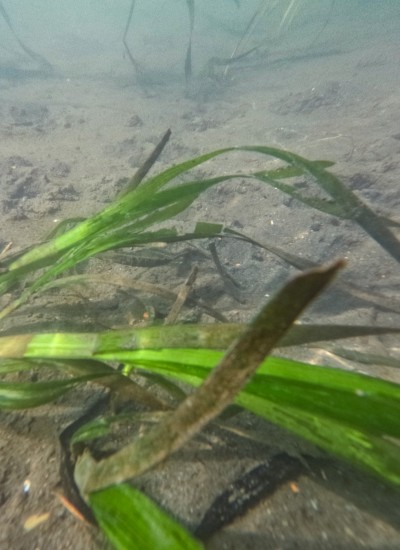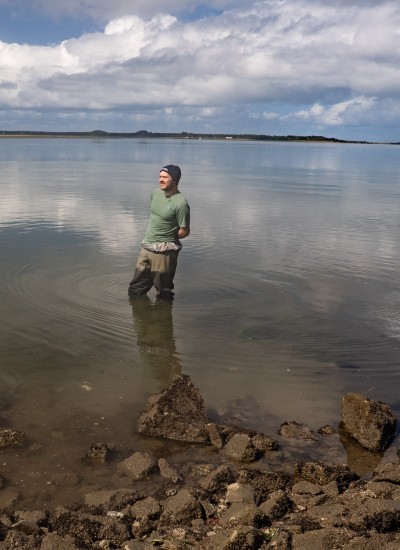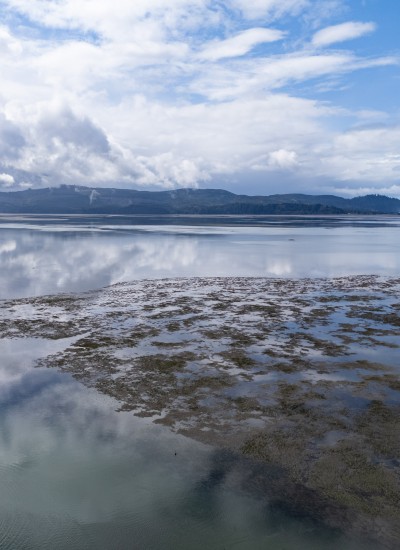Sarah Yeoman | 3-minute read
“Eelgrass is the climate underdog a lot of folks aren’t aware of,” says Annie Merrill, the marine conservation manager at Oregon Shores Conservation Coalition. “It’s [a] nursery habitat for juvenile species that are super important to our fishers and cultural species. Dungeness crab, herring, salmon, a variety of shellfish – it’s really critical for protecting those baby fish when they are really young and vulnerable.”
Eelgrass is the only species of seagrass in Oregon, and unlike seaweed or kelp, it has a root system embedded in the coastal sediment providing structure for essential habitats and water filtration. Oregon’s land use Goal 16, covering estuarine resources, is in place to protect the environmental, economic, and social benefits of the state’s estuaries. “There’s a clear connection between land use decisions in the watershed and impact on the estuary because everything ends up there,” Annie says. The Department of Land Conservation and Development is leading the effort to update estuary plans and zoning, in part to protect eelgrass meadows, with Tillamook and Coos Counties both getting new Estuarine Resilience Action Plans in 2023.
Without eelgrass, “We’d have essentially a desert of mudflats in our estuaries,” says Flynn Delany, a field and data scientist with Tillamook Estuaries Partnership. “So it’s a really, really critical component of creating a biodiverse habitat and protecting vital species for the local community and industry.”

This important marine plant also has mighty carbon-sequestration capabilities, drawing carbon from the waters surrounding it and storing it through its roots into the sediment below. “Seagrass is estimated to sequester carbon at 35 times the rate of tropical rainforests,” Annie says. “Ten percent of all carbon sequestration happening in the ocean is attributed to seagrass.”
But seagrasses in general across the Pacific Northwest are in decline, and the threats to eelgrass in Oregon are growing. Its depth range is limited – too deep and sunlight can’t reach it, too shallow and it will be exposed too often. The effects of human impact – like the use of herbicides on land, boating, and visitors interacting with the shoreline – are increasing. Dredging and other physical disturbances uproot eelgrass meadows and churn estuary waters, blocking out sunlight or burying the grasses completely. “There’s going to be overlap that’s going to cause tension when there’s a limited amount of space that people can use,” Flynn says.

The increasing frequency of extreme heat events also poses a major threat to eelgrass. According to Flynn, when a marine heatwave hit Oregon several years ago, it killed off a large population of eelgrass in Coos Bay. “It was just the luck of the draw that [Tillamook] wasn’t impacted by that,” he says. “But at this point, it’s not a matter of if, but when, we experience something like that again.”
Preparation and awareness, Flynn says, are key. Since eelgrass is the only species of seagrass in Oregon, it’s more vulnerable to stressors and has less ability to recover than meadows that have more diverse seagrass varieties. On the East Coast, eelgrass is faring poorly due to eutrophication and algal blooms, but Flynn says, “We are learning a lot from that exchange of information, and we’re being prepared to protect it here in the future.” Tillamook Estuaries Partnership has started an annual eelgrass-monitoring program, using remote images, satellite data, and down-and-dirty hands-on research looking at specific meadows to watch for signs of disease and declining health. That way, Flynn says, they can respond to any potential warning signs as quickly as possible.

House Bill 3580, which is making its way through the legislative process this session, would establish a task force of scientists, Tribes, stakeholders, and state agencies to develop recommendations to protect, conserve, and enhance eelgrass resources. 1000 Friends of Oregon is actively supporting the bill, with the understanding that strong marine ecosystems fall under our mission to protect Oregon habitats for generations to come. “There’s an opportunity to think more holistically about estuaries and climate stressors in that land use plan, and strengthen protections for eelgrass,” Annie says.
Decision-makers need to have the proper knowledge of estuaries and eelgrass, Flynn says, but the general public will benefit from understanding its necessity to biodiversity as well. “Seagrass is carrying a lot of weight with the health of our estuaries,” he says. “It’s really turning what would be a desert of mudflats into a true meadow of life. That’s kind of inspiring, and I wish more people knew about it.”
1000 Friends of Oregon is working hard to promote smart land use, from ranchland in Umatilla County to estuaries in Tillamook Bay. This Earth Month, consider supporting our advocacy work with a contribution.
